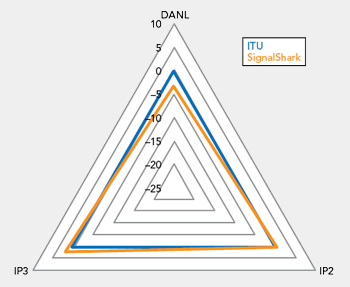How Does Dynamic Range Affect a Spectrum Analyzer?

In-field test engineers constantly face obstacles with interference signals being too weak when monitoring mobile phone interference in urban areas. Such signals are often below the noise floor of the measuring instrument, for example, a spectrum analyzer.
How Does Dynamic Range Affect a Spectrum Analyzer?
Instruments like a spectrum analyzer will rely on a high dynamic range to cut through unwanted artifacts. Harmonics and intermodulation can rise above the noise floor and hurt the performance of a spectrum analyzer. Understanding the parameters that make up dynamic range can not only help to ensure a spectrum analyzer is working correctly, but also offers key information on all instruments which should meet ITU guidelines.Dynamic Range
A high dynamic range offers a solution for these false signals. With a high dynamic range, spectrum analyzers and other test instruments can conceal or decrease second harmonics.Dynamic range is the area where the minimum to maximum strength signals can be detected and measured before artifacts appear above the noise floor. Generally, a higher dynamic range comes when this area is larger or the amplitude of the artifacts is smaller. High dynamic range also reduces the chances that these artifacts, like harmonics, are mistaken for real signals. Ideally, an instrument will have a higher intermodulation free dynamic range (IMFDR). A device's IMFDR is the dynamic range where unwanted intermodulation is still below the noise floor.
The term high dynamic range (HDR) is often applied to both spectrum analyzers and radio receivers. Even with large signals in the area, a device with HDR can register those small signals. To achieve HDR, the spectrum analyzer first needs high sensitivity for signals at a small level. The device also needs an ability to cut through congestion caused by those large signals.

Harmonics - As mentioned above, second harmonics occur at twice the frequency of an input signal. Higher-order (i.e., nth-order) harmonics occur at n times the frequency of the input. Harmonics can only occur when a signal is present, usually when radiofrequency components in the device work with an increased power level in nonlinear regions.
Intermodulation - Another artifact from an RF component working in nonlinear regions in intermodulation. But, unlike harmonics, intermodulation mixes two or more signals to make a new input frequency. For example, the second-order intermodulation frequencies of the frequencies f1 and f2 are f1 + f2 and f2 – f1 and the third-order intermodulation frequencies are 2f1 + f2, 2f2 + f1, 2f1 – f2 and 2f2 – f1.
Signal Levels
Artifacts will also greatly change depending on how the input signal changes. For example, the dB of a second-order artifact will change by double the size of the input change. A third-order artifact will similarly triple the change of an input signal change.Intercept points also differ based on the instrument's dynamic range and input attenuation. This is how intercept points are presented, depending on the artifact:
- IP2/SOI: the second-order intercept point, based on the intermodulation products.
- IP3/TOI: The third-order intercept point, based on the intermodulation products.
- SHI: The second-order intercept point, based on harmonics.
- THI: The third-order intercept point, based on harmonics.
Intercept Points
Output power, and its related harmonics, directly reflect input power. As the input power increases with that linear relationship, output signal power will intersect with the artifact's level. When it comes to third-order intermodulation, that intercept point is called the TOI or IP3. At this point, the signals are equal, with the level difference and dynamic range between third-order artifacts and target signal at 0 dB. The other intercept points have similar names and definitions: IP2/SOI, SHI, and THI. SHI represents dynamic range when a single strong signal that creates harmonics interferes with the measurement of a weak signal. THI occurs when two or more strong input signals cause harmonics that interfere.
The other intercept points have similar names and definitions: IP2/SOI, SHI, and THI. SHI represents dynamic range when a single strong signal that creates harmonics interferes with the measurement of a weak signal. THI occurs when two or more strong input signals cause harmonics that interfere.Intercept points will vary depending on factors like second- or third-harmonics and intermodulation.
DANL
Intercept points aren't the only key aspect to the IMFDR of an instrument. The other factor displayed averaged noise level (DANL). The measuring system for an instrument depends on its natural noise. A lower noise floor results in a greater dynamic range. System sensitivity, RBW setting, and thermal noise will all affect the DANL.To find a dynamic range, instrument settings should be the same whether testing for IP2, IP3, DANL, or noise figure (NF).
ITU Recommendations

There are some simple ways to represent the ITU's recommendations, like in Table 1 above. Although, other figures can make dynamic range and its related parameters easier to read. The triangle to the right offers figures like DANL, IP2, IP3, and dynamic range. A larger triangle means a better dynamic range, creating a figure that's better to compare performance.
To the right in Figure 2, we see both an ideal performance based on ITU recommendations and the performance of the SignalShark spectrum analyzer. Parameters for the SignalShark come from Narda Safety Test Solutions. The SignalShark has an NF of 15dB, higher than the ITU recommended 12 dB. Narda's spectrum analyzer also surpasses ITU recommendations for IP3 by 2 dB, while nearly matching the IP2 above 20MHz.
A high dynamic range may be crucial to spectrum analyzer performance, but many factors make up that information. DANL, IP2, IP3, and their relationships to ITU guidelines offer key information on a dynamic range. With these figures and the triangle diagram to the right, users can better understand spectrum analyzers and other instruments that rely on a high dynamic range.
Sources: Microwave Journal
Posted October 28, 2020
